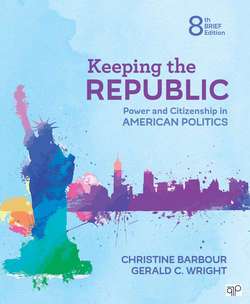Читать книгу Keeping the Republic - Christine Barbour - Страница 82
На сайте Литреса книга снята с продажи.
The Executive Branch
ОглавлениеThe executive is the part of government that “executes” the laws, or sees that they are carried out. Although technically executives serve in an administrative role, many end up with some decision-making or legislative power as well. National executives are the leaders of their countries, and they participate, with varying amounts of power, in making laws and policies. That role can range from the U.S. president—who, though not a part of the legislature itself, can propose, encourage, and veto legislation—to European prime ministers, who are part of the legislature and may have, as in the British case, the power to dissolve the entire legislature and call a new election.
executive the branch of government responsible for putting laws into effect
The fact that the Articles of Confederation provided for no executive power at all was a testimony to the founders’ conviction that such a power threatened their liberty. The chaos that resulted under the Articles, however, made it clear to founders like Alexander Hamilton that a stronger government was called for, not only a stronger legislature but a stronger executive as well. The constitutional debates reveal that many of the founders were haunted by the idea that they might inadvertently reestablish the same tyrannical power over themselves that they had only recently escaped with the Revolution.
THE RULES The solution finally chosen by the founders is a complicated one, but it satisfied all the concerns raised at the convention. The president, a single executive, would serve an unlimited number of four-year terms. (A constitutional amendment in 1951 limited the president to two elected terms.) But the president would be chosen neither by Congress nor directly by the people. Instead, the Constitution provides for the president’s selection by an intermediary body called the Electoral College. Citizens vote not for the presidential candidates but for a slate of electors, who in turn cast their votes for the candidates about six weeks after the general election. The founders believed that this procedure would ensure a president elected by well-informed delegates who, having no other lawmaking power, could not be bribed or otherwise influenced by candidates. We say more about how this works in Chapter 12, on elections.
Article II of the Constitution establishes the executive branch. The four sections of that article make the following provisions:
Section 1 sets out the four-year term and the manner of election (that is, the details of the Electoral College). It also provides for the qualifications for office: that the president must be a natural-born citizen of the United States, at least thirty-five years old, and a resident of the United States for at least fourteen years. The vice president serves if the president cannot, and Congress can make laws about succession if the vice president is incapacitated.
Section 2 establishes the powers of the chief executive. The president is commander-in-chief of the armed forces and of the state militias when they are serving the nation, and he has the power to grant pardons for offenses against the United States. With the advice and consent of two-thirds of the Senate, the president can make treaties, and with a simple majority vote of the Senate, the president can appoint ambassadors, ministers, consuls, Supreme Court justices, and other U.S. officials whose appointments are not otherwise provided for.
Section 3 says that the president will periodically tell Congress how the country is doing (the State of the Union address given every January) and will propose to them those measures that he thinks appropriate and necessary. Under extraordinary circumstances, the president can call Congress into session or, if the two houses of Congress cannot agree on when to end their sessions, can adjourn them. The president also receives ambassadors and public officials, executes the laws, and commissions all military officers of the United States.
Section 4 specifies that the president, vice president, and other civil officers of the United States (such as Supreme Court justices) can be impeached, tried, and convicted for “Treason, Bribery, or other high Crimes and Misdemeanors.”
